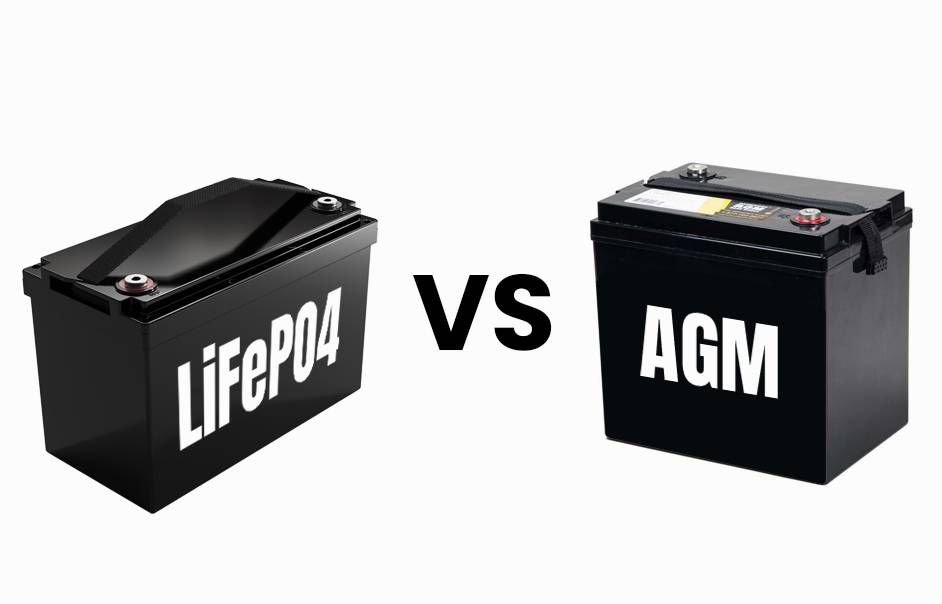Blog
LFP vs AGM Battery: 10 Key Differences You Should Know Before Buying
2025-07-25 | Eric

Batteries are everywhere—from cars to solar power systems, RVs to backup storage. Among the most popular types are LFP (Lithium Iron Phosphate) and AGM (Absorbent Glass Mat) batteries. While both are designed for energy storage, they’re built with completely different technologies, and their performance varies widely.
So, which one should you choose? In this article, we break down the 10 biggest differences between LFP and AGM batteries to help you make the right decision.
What Is an LFP Battery?
LFP (LiFePO4) battery, short for Lithium Iron Phosphate, is a type of lithium-ion battery known for its safety, longevity, and high energy density. It uses lithium iron phosphate as the cathode and carbon as the anode, with a nominal voltage of 3.2V per cell. LFP batteries have become increasingly popular in electric vehicles, solar systems, and industrial applications.
What Is an AGM Battery?
AGM (Absorbent Glass Mat) battery is a type of sealed lead-acid battery (VRLA). It uses glass fiber separators to hold the electrolyte (sulfuric acid) in place, which helps prevent leaks. With a nominal voltage of 2.0V per cell, AGM batteries have been around for decades and are still widely used in cars, UPS systems, and marine applications.
LFP vs AGM: The 10 Key Differences
Let’s take a closer look at how these two battery types stack up.
1. Weight & Size
- LFP batteries are much lighter and more compact.
- They weigh about half as much as AGM batteries with the same capacity.
- Ideal for mobile applications like RVs or off-grid systems where space and weight matter.
✅ Winner: LFP Battery
2. Energy Density
- LFP: 90–210 Wh/kg
- AGM: 50–70 Wh/kg
LFP batteries can store more energy per kilogram, meaning you get more power in less space.
✅ Winner: LFP Battery
3. Usable Capacity (Depth of Discharge)
- LFP: Up to 80–90% DoD (Depth of Discharge)
- AGM: Only 50% DoD is recommended to maintain lifespan
To get the same usable energy, you’d need to buy a larger AGM battery.
✅ Winner: LFP Battery
4. Lifespan & Cycle Life
- LFP batteries: 3,000–7,000 charge cycles, lasting 10+ years
- AGM batteries: 500–1,200 cycles, lasting 3–5 years
LFP batteries offer long-term value thanks to their extended lifespan.
✅ Winner: LFP Battery
5. Charging & Discharging Performance
- LFP batteries charge faster (up to 1C or more)
- AGM batteries charge slower and risk damage at high rates (recommended 0.3–0.5C)
For time-sensitive operations or solar setups, LFP batteries save hours in charging time.
✅ Winner: LFP Battery
6. Temperature Tolerance
- AGM batteries perform better in cold climates and can charge below 0°C
- LFP batteries struggle below 0°C but perform excellently at high temperatures
If you're operating in cold environments, AGM might be the better pick. But for hot or moderate climates, LFP wins hands down.
Tie – depends on your climate
7. Safety
- LFP batteries are among the safest lithium-ion batteries available.
No risk of explosion even if punctured or crushed - AGM batteries contain sulfuric acid and lead, which can leak or release harmful gases if damaged.
✅ Winner: LFP Battery
8. Environmental Impact
- LFP batteries are non-toxic, recyclable, and free from heavy metals.
- AGM batteries contain lead, a hazardous material that poses environmental risks.
✅ Winner: LFP Battery
9. Self-Discharge Rate & Storage
- LFP: 2–3% per month
- AGM: 4–6% per month
- LFP batteries retain charge longer and can be stored at 50% capacity, while AGM needs to be fully charged during storage.
✅ Winner: LFP Battery
10. Cost & Value
- Upfront cost: LFP batteries are 2–3 times more expensive
- Long-term cost: LFP lasts longer, requires fewer replacements, and saves on maintenance
While AGM is more affordable initially, LFP provides greater value over time.
Depends on your budget – but LFP pays off in the long run
So, Which Battery Should You Choose?
| Factor | LFP Battery | AGM Battery |
|---|---|---|
| Weight | ✅ Lighter | ❌ Heavier |
| Lifespan | ✅ 10+ years | ❌ 3–5 years |
| Safety | ✅ Excellent | ❌ Moderate |
| Energy Density | ✅ High | ❌ Low |
| Cold Weather | ❌ Weaker | ✅ Better |
| Cost | ❌ Higher | ✅ Lower upfront |
If you’re on a tight budget or live in cold environments, AGM batteries are still a decent choice.
But if you want a longer lifespan, better performance, and higher safety standards, investing in LFP batteries is worth every penny. In fact, many industries and homeowners are now upgrading their old lead-acid systems with LFP for greater reliability and ROI.
Ready to Upgrade?
Whether you're powering an RV, solar system, or industrial equipment, choosing the right battery can make or break your setup.
Popular Articles
Contact Details
Worktime :Monday to Friday 9am - 6pm (HKT)
WhatsApp/Wechat/Mobile :+86XXXXX
Email : info@lifepo4cellstore.com
